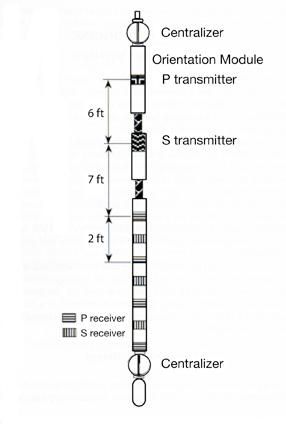Dipole Shear Sonic Tool (SST)
The Dipole Shear Sonic Tool was developed at Lamont-Doherty Earth Observatory. It consisted of a piezoceramic monopole compresional wave transmitter (12-14 kHz), a wideband dipole shear wave transmitter (2-4 kHz), and a semirigid receiver array, including four compressional wave and three shear wave receivers. The transmitters were separated from the receiver string with flexible acoustic isolators. In contrast to a nondirectional monopole source, the dipole transmitter created unidirectional flexing of the borehole wall, which excites shear waves. The LDEO-SST also included an orientation module for recording azimuthal orientation of the shear transmitter and receivers.
The LDEO-SST could measure compressional and Stonely wave velocities, and it could directly measure shear wave velocities in “soft” formations in which the shear wave velocity is equal or less than the velocity of the drilling fluid, such as in water-saturated clays. Full waveforms from the compressional and shear wave receivers were digitally recorded by an industrial log-data acquisition system, which also controlled tool operations. Computer software developed for the tool allowed for conventional first-motion detection methods for determining wave propogation velocities. Recorded waveforms could be used for post-cruise analysis to extract additional information, such as sonic wave attenuation and signal spectrums.
The LDEO-SST was deployed on the Blake Ridge during ODP Leg 164 in 1995.
Applications
Porosity and lithology. The ratio of compressional to shear wave velocities provides information on porosity, lithology, and the dispersion of Stonely waves, which yields useful permeability and fracture data.
Gas hydrates. Compressional and shear wave ratios can also be used to assess the amount of gas hydrates in a sedimentary sequence.
Major Outputs
| VP: | Compressional velocity (km/sec) |
| VS: | Shear velocity (km/sec) |
Deployment Notes
The SST was run as a stand-alone tool.

